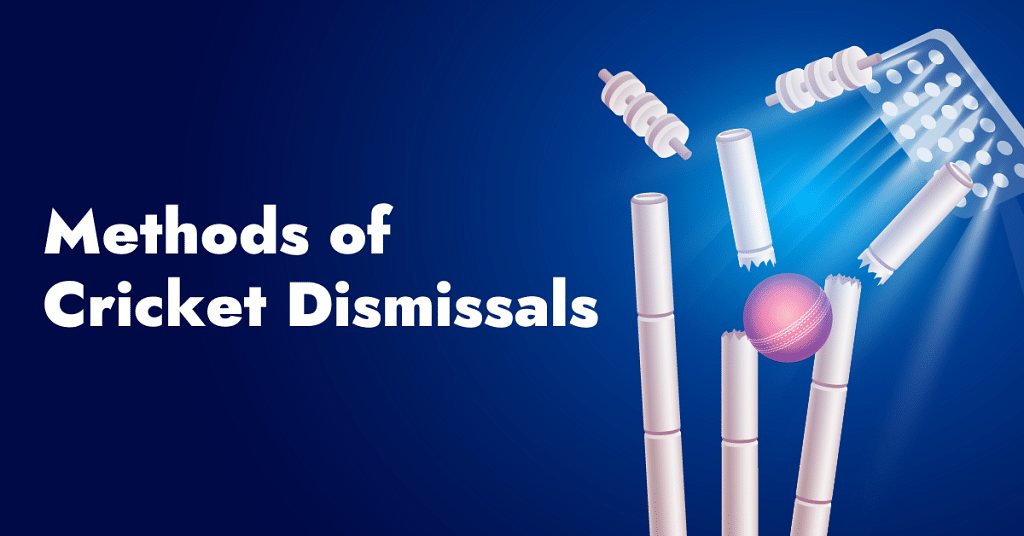Types of out in cricket- Have you ever thought about the different types of out in cricket and their impact? Cricket is a fascinating sport that has several rules and regulations. One of the main rules of cricket is the different types of dismissals that can occur.
In this blog post, we’ll discuss the different types of dismissals and how they are completed in cricket. With this guide, you’ll gain a better understanding of the game.
What is a Dismissal in Cricket?- Types of out in Cricket
Dismissals are critical in cricket as they can turn the game in favor of one team over another, making them an integral part of the game strategy and are used to determine the game’s outcome.
A dismissal occurs when a batter is out or retires. There are various options for a batsman to be ‘out.’
Types of out in Cricket
Understanding how these different types of out in cricket works are necessary for any cricket player or cricket enthusiast that wants to have a perfect knowledge of the game.
Without further ado, let’s look at some of the types of out in cricket:
- Caught out
- Run out
- Stumped
- Hit wicket
- Handled the ball
- Obstructing the field.
Leg Before Wicket (LBW)
LBW is a type of dismissal where the batsman is out when the bowler bowls a delivery that hits the batsman’s pads, preventing him from hitting the ball, and it would have gone on to hit the stumps.
This type of dismissal is the most common in cricket and holds great significance. This rule states that if the bowler is deemed to have delivered a ball that would have hit the stumps and the batsman has not been able to play a shot, then the umpire must make a judgment on whether or not it would have hit the stumps, and if so, then they will call Out LBW.
Caught Out
In cricket, a batter can be caught out when a fielder catches the ball before it touches the ground. It is the most common out in cricket and can be achieved by any fielder. It is often referred to as a “caught behind.”
The fielder who catches the ball must show complete control of the ball before it touches the ground for it to be considered an out.
The laws and rules of cricket are designed to ensure that any out that occurs within the bounds of fairness and accuracy is an integral part of this popular sport.
Bowled Out
A Bowled Out occurs when a batsman is dismissed by the bowler delivering a ball that knocks over their stumps. It is one of the main methods of cricket dismissals, whereby the bowler’s delivery knocks down the stumps with the ball still in play.
All these methods require different skill sets and are integral components in cricket dismissals
Stumped Out
A Stumped-out is seen as one of the most impressive dismissals in cricket and can often turn a game around. Similarly, a stumped-out is when the batsman does not hit the ball, and the wicketkeeper collects it before the batter can get back in the crease.
Run Out
A Run out is when a fielder either takes hold of the ball, fields it cleanly and then hits the stumps with the ball while the batsman is out of his crease. This can also be done if the fielder throws the ball to another fielder, who then breaks the wicket.
The fielder must dislodge at least one bail must for a run out to be given. If the batsman has both feet on their crease while being run out, they are not dismissed. However, if they leave their crease even slightly before being bowled, they can be given out.
Obstructing The Field
When a batter deliberately interferes with a fielder’s attempt to collect the ball or make a runout. The ball may not be deliberately swatted away by standing between the fielder and the wicket to prevent the fielder from throwing the stumps down with the ball. Still, it can be deliberately and deliberately swatted away by that fielder.
Hit Wicket
Batters who attempt to hit a ball or take off for a first run may break a wicket when they touch it. It includes bats and dislodged parts of batsman’s equipment, such as glasses and helmets.
Timed Out
Timed out happens when a new batsman takes more than two minutes to appear on the pitch after the last wicket has fallen.
Final thoughts for Dismissals in Cricket
Understanding the different types of dismissals in cricket is essential for anyone who wants to learn more about the game. Whether it’s a batsman getting out to a bowler or fielder, or a batsman getting run out, all of these types of dismissals have their own set of rules and conditions that must be followed.
People also ask about Dismissals in Cricket
- What are the different types of outs in cricket?
There are six Test matches. The six most common methods of dismissal are caught, bowled, lbw stumped, run out, and hit wicket.
- Which method of dismissal is least common in Test cricket?
Obstructing the field is the least common method in Test Cricket. Only one player has been dismissed in Test cricket for ‘obstructing the field.’
- What are the different methods of dismissing a batter?
The six most common methods of dismissal are caught, bowled, caught behind, leg bye, stumped, and run out. If you want to know more about cricket check the Fun88 Blog site. Here you will get all the sports and cricket related information and news.
Related Read: Online Cricket Betting Tips For Punters To Win Big
Star it if you find it helpful.

